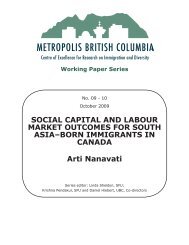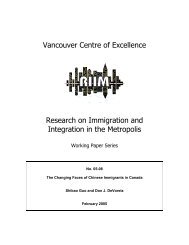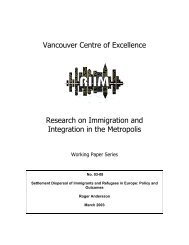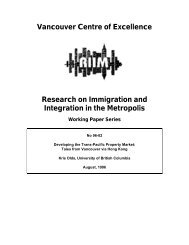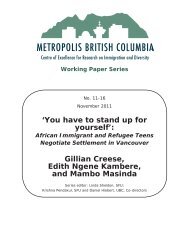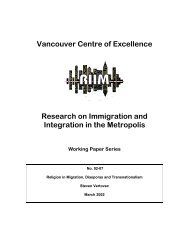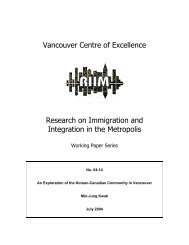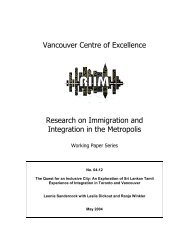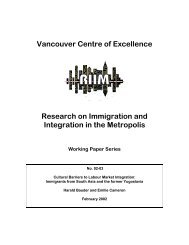Characteristics of Immigrant Transnationalism in ... - Metropolis BC
Characteristics of Immigrant Transnationalism in ... - Metropolis BC
Characteristics of Immigrant Transnationalism in ... - Metropolis BC
You also want an ePaper? Increase the reach of your titles
YUMPU automatically turns print PDFs into web optimized ePapers that Google loves.
3<br />
Introduction<br />
<strong>Transnationalism</strong> is one <strong>of</strong> a series <strong>of</strong> supra-national processes that has been discussed with<strong>in</strong> the<br />
theoretical lens <strong>of</strong> globalisation. If globalisation represents a larger ‘space <strong>of</strong> flows’ that is said to<br />
overrun national borders to shape more expansive regional and global geographies, then transnational<br />
migration is one <strong>of</strong> those flows, the movement <strong>of</strong> labour that accompanies the reconfiguration <strong>of</strong><br />
national economies and societies. Like the movement <strong>of</strong> capital, it seems, labour has now liberated<br />
itself from conta<strong>in</strong>ment with<strong>in</strong> national borders to engage <strong>in</strong> both cont<strong>in</strong>u<strong>in</strong>g movement and<br />
communication between countries <strong>of</strong> orig<strong>in</strong> and dest<strong>in</strong>ation and also to establish a status <strong>of</strong> flexible<br />
identification <strong>in</strong> terms <strong>of</strong> national citizenship.<br />
It is no surprise that transnational migrants touch down at precisely the same sites as John<br />
Friedmann (1986) first identified as the ‘bas<strong>in</strong>g po<strong>in</strong>t’ <strong>of</strong> the new globalis<strong>in</strong>g economy, the global cities<br />
that act as gateways between national societies and the world system. In Canada, Toronto and<br />
Vancouver have emerged as the nation’s two primary w<strong>in</strong>dows on the world. In 2001, they <strong>in</strong>cluded<br />
some <strong>of</strong> the highest proportions <strong>of</strong> the foreign-born anywhere <strong>in</strong> the advanced societies, 43 percent <strong>in</strong><br />
the Toronto census metropolitan area (CMA) and 37 percent <strong>in</strong> the Vancouver CMA. Moreover a<br />
substantial proportion <strong>of</strong> these people are newcomers, land<strong>in</strong>g between 1991 and 2001, amount<strong>in</strong>g to 39<br />
percent <strong>of</strong> the immigrant population <strong>in</strong> Toronto and 44 percent <strong>in</strong> Vancouver. These percentages<br />
translate <strong>in</strong>to large numbers, consist<strong>in</strong>g <strong>of</strong> 792,000 land<strong>in</strong>gs <strong>in</strong> Toronto and 325,000 <strong>in</strong> Vancouver <strong>in</strong><br />
the 1991-2001 period; amongst this recently arrived cohort <strong>in</strong> particular we might expect to see<br />
considerable transnational activity.<br />
The landscapes and social geographies <strong>of</strong> both cities have undergone significant restructur<strong>in</strong>g <strong>in</strong><br />
the past decade. An important development has been the suburbanisation <strong>of</strong> the immigrant population,<br />
no longer conf<strong>in</strong>ed to older <strong>in</strong>ner city reception areas, but now <strong>in</strong>clud<strong>in</strong>g substantial concentrations <strong>in</strong><br />
<strong>in</strong>ner suburbs, where proportions run as high as 54 percent <strong>in</strong> Richmond <strong>in</strong> 2001 and 47 percent <strong>in</strong><br />
Burnaby, compared with a City <strong>of</strong> Vancouver share <strong>of</strong> 46 percent foreign-born (compare Hiebert 1999;<br />
Rose 2001). Moreover the composition <strong>of</strong> immigrant cohorts <strong>in</strong> Vancouver has strongly favoured the<br />
economic classes <strong>of</strong> <strong>in</strong>dependent and bus<strong>in</strong>ess migrants, more so than <strong>in</strong> any other Canadian urban<br />
centre. The high human capital and substantial f<strong>in</strong>ancial assets <strong>of</strong> members <strong>of</strong> these groups have<br />
permitted residential selection <strong>in</strong> the region’s high status districts, <strong>in</strong>clud<strong>in</strong>g the premier neighbourhood<br />
<strong>of</strong> Shaughnessy, where significant landscape change has occurred, lead<strong>in</strong>g to a notable conflict, s<strong>in</strong>ce<br />
resolved, <strong>in</strong> the early 1990s on appropriate hous<strong>in</strong>g and landscape styles (Ley 1995). The impact <strong>of</strong>



